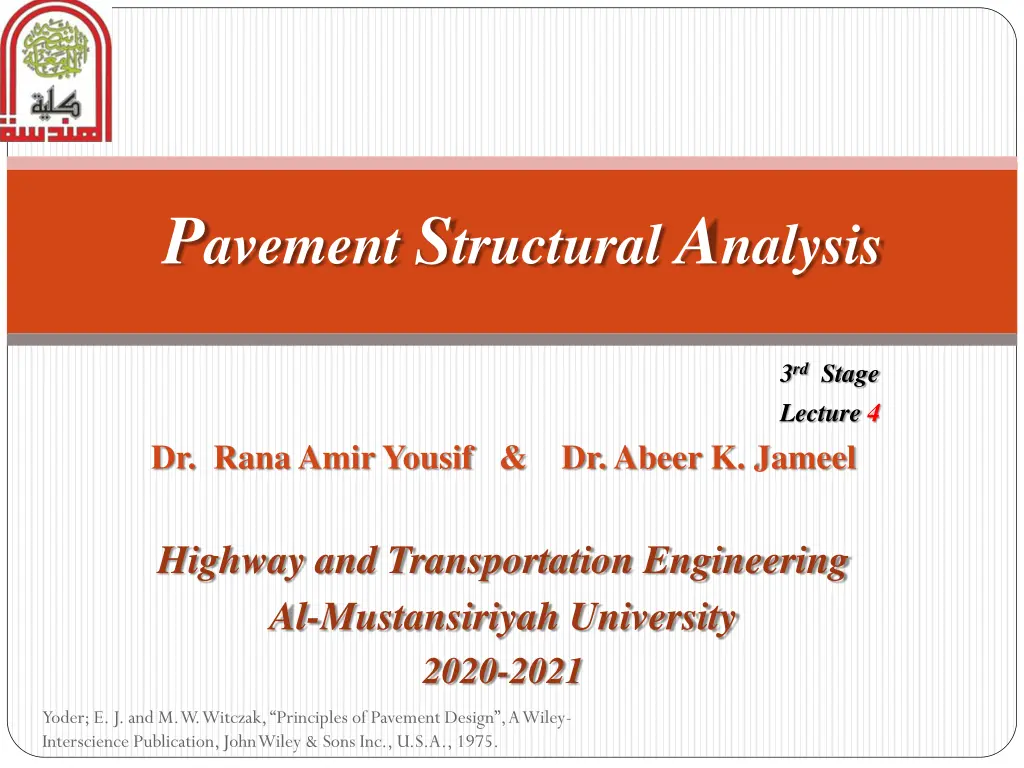
Pavement Structural Analysis Insights
Explore the structural analysis of pavements in highway engineering, focusing on stresses, strains, and deflections under various loading conditions. Learn how to determine critical stresses and deflections at different points on a pavement surface. Dive into examples illustrating stress calculations and Poisson ratio effects in pavement design principles.
Download Presentation

Please find below an Image/Link to download the presentation.
The content on the website is provided AS IS for your information and personal use only. It may not be sold, licensed, or shared on other websites without obtaining consent from the author. If you encounter any issues during the download, it is possible that the publisher has removed the file from their server.
You are allowed to download the files provided on this website for personal or commercial use, subject to the condition that they are used lawfully. All files are the property of their respective owners.
The content on the website is provided AS IS for your information and personal use only. It may not be sold, licensed, or shared on other websites without obtaining consent from the author.
E N D
Presentation Transcript
Pavement Structural Analysis 3rdStage Lecture 4 Dr. RanaAmir Yousif & Dr. Abeer K. Jameel Highway and Transportation Engineering Al-Mustansiriyah University 2020-2021 Yoder; E. J. and M. W. Witczak, Principles of Pavement Design , A Wiley- Interscience Publication, John Wiley & Sons Inc., U.S.A., 1975.
References: Nicholas J. Garber and Lester A. Hoel. Traffic and Highway Engineering , Fourth Edition. Yoder; E. J. and M. W. Witczak, Principles of Pavement Design , A Wiley- Interscience Publication, John Wiley & Sons Inc., U.S.A., 1975. Yaug H. Huang, Pavement Analysis and Design , Prentic Hall Inc., U.S.A., 1993. AASHTO Guide for Design of Pavement Structures 1993 , AASHTO, American Association of State Highway and Transportation Officials, U.S.A., 1993. Oglesby Clarkson H., HighwayEngineering , John Wiley & Sons Inc., U.S.A., 1975. Yoder; E. J. and M. W. Witczak, Principles of Pavement Design , A Wiley- Interscience Publication, John Wiley & Sons Inc., U.S.A., 1975.
Stresses in Pavements 2.1.2. Solutions at Axis of Symmetry When the load is applied over a single circular loaded area, the most critical stress ,strain, and deflection occur under the center of the circular area on the axis of symmetry, where = 0 and r = t, so z and r, are the principal stresses . Flexible Plate : The load applied from tire to pavement is similar to a flexible plate with a radius a and a uniform pressure q. The stresses beneath the center of the plate can be determined from z is independen t of E and v r is independent of E Yoder; E. J. and M. W. Witczak, Principles of Pavement Design , A Wiley- Interscience Publication, John Wiley & Sons Inc., U.S.A., 1975.
Stresses in Pavements The vertical deflection w can be determined from Yoder; E. J. and M. W. Witczak, Principles of Pavement Design , A Wiley- Interscience Publication, John Wiley & Sons Inc., U.S.A., 1975.
Stresses in Pavements When v = 0 .5, Eq. 2.6 can be simplified to Note On the surface of the half-space, z = 0 ; from Eq . 2 .6 , Yoder; E. J. and M. W. Witczak, Principles of Pavement Design , A Wiley- Interscience Publication, John Wiley & Sons Inc., U.S.A., 1975.
Example (2.2) : Same as Example 2 .1, except that only the left loaded area exists and the Poisson ratio is 0.3, as shown in Figure 2.8 . Determine the stresses, strains, and deflection at point A . Yoder; E. J. and M. W. Witczak, Principles of Pavement Design , A Wiley- Interscience Publication, John Wiley & Sons Inc., U.S.A., 1975.
Solution Example (2.2) : Given :- q = 50 psi z = 10.0 in a value = D/2 a = 5.0 in From Eq. 2.2, = 14.2 psi With v = 0.3, from Eq. 2.3 , = -0.25 psi The negative sign indicates tension which is in contrast to a compressive stress of 0 .8 psi (5.5 kPa) when v = 0 .5. Yoder; E. J. and M. W. Witczak, Principles of Pavement Design , A Wiley- Interscience Publication, John Wiley & Sons Inc., U.S.A., 1975.
Solution: From Eq .2.4, = 0 .00144. From Eq .2.5, = -0 .00044. From Eq .2.6, = 0 .0176. The results obtained from KENLAYER are z = 14.2 psi r = -0 .249 psi which are nearly the same as those derived from the formulas. Yoder; E. J. and M. W. Witczak, Principles of Pavement Design , A Wiley- Interscience Publication, John Wiley & Sons Inc., U.S.A., 1975.
Rigid Plate : All the above analyses are based on the assumption that the load is applied on a flexible plate, such as a rubber tire . If the load is applied on a rigid plate, such as that used in a plate loading test, the deflection is the same at all points on the plate , but the pressure distribution under the plate is not uniform. The differences between a flexible and a rigid plate are shown in Figure 2.9 . The pressure distribution under a rigid plate can be expressed as (Ullidtz, 1987 ) Yoder; E. J. and M. W. Witczak, Principles of Pavement Design , A Wiley- Interscience Publication, John Wiley & Sons Inc., U.S.A., 1975.
in which: r is the distance from center to the point where pressure is to be determined and q is the average pressure, which is equal to the total load divided by the area . The smallest pressure is at the center and equal to one-half of the average pressure . The pressure at the edge of the plate is infinity . By integrating the point load over the area , it can be shown that the deflection of the plate is A comparison of Eq . 2.10 with Eq. 2 .8 indicates that the surface deflection under a rigid plate is only 79% of that under the center of a uniformly distributed load . This is reasonable because the pressure under the rigid plate is smaller near the center of the loaded area but greater near the edge . The pressure near the center has a greater effect on the surface deflection at the center . Although Eqs .2.8 and 2.10 are based on a homogeneous half-space, the same factor, 0 .79, can be applied if the plates are placed on a layer system, as indicated by Yoder and Witczak (1975) . Yoder; E. J. and M. W. Witczak, Principles of Pavement Design , A Wiley- Interscience Publication, John Wiley & Sons Inc., U.S.A., 1975.
Example (2.3) : A plate loading test using a plate of 12-in . (305-mm) diameter was performed on the surface of the sub-grade, as shown in Figure 2.10 . A total load of 8000 lb (35 .6 kN) was applied to the plate, and a deflection of 0 .1 in . (2.54 mm) was measured . Assuming that the sub-grade has Poisson ratio 0 .4, determine the elastic modulus of the sub-grade . Solution: The average pressure on the plate is q = 8000/(367r) = 70 .74 psi (488 kPa) . From Eq. 2.10, E = all 0 .16) x 70 .74 x 6/(2 x 0 .1) = 5600 psi (38 .6 MPa) . Yoder; E. J. and M. W. Witczak, Principles of Pavement Design , A Wiley- Interscience Publication, John Wiley & Sons Inc., U.S.A., 1975.
Class work: 1 A plate loading test using a plate of 12-in . diameter was performed on the surface of the sub-grade, as shown in Figure below . A total load of 9500 lb was applied to the plate, and a deflection of 0.11 in . was measured . Assuming that the sub-grade has Poisson ratio 0 .3, determine the elastic modulus of the sub-grade . 12 in. 9500 lb Rigid Plate Deflects 0.11in v=0.3 E=? Yoder; E. J. and M. W. Witczak, Principles of Pavement Design , A Wiley- Interscience Publication, John Wiley & Sons Inc., U.S.A., 1975.
Pavement Structural Analysis Dr. Rana Amir Yousif & Dr. Abeer K. Jameel Yoder; E. J. and M. W. Witczak, Principles of Pavement Design , A Wiley- Interscience Publication, John Wiley & Sons Inc., U.S.A., 1975.






















